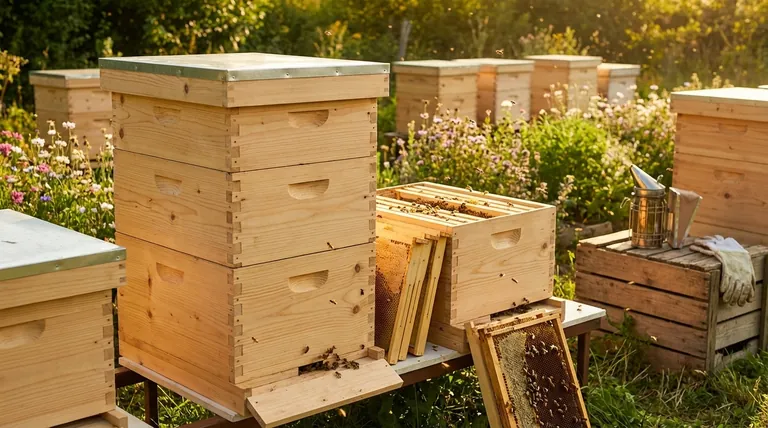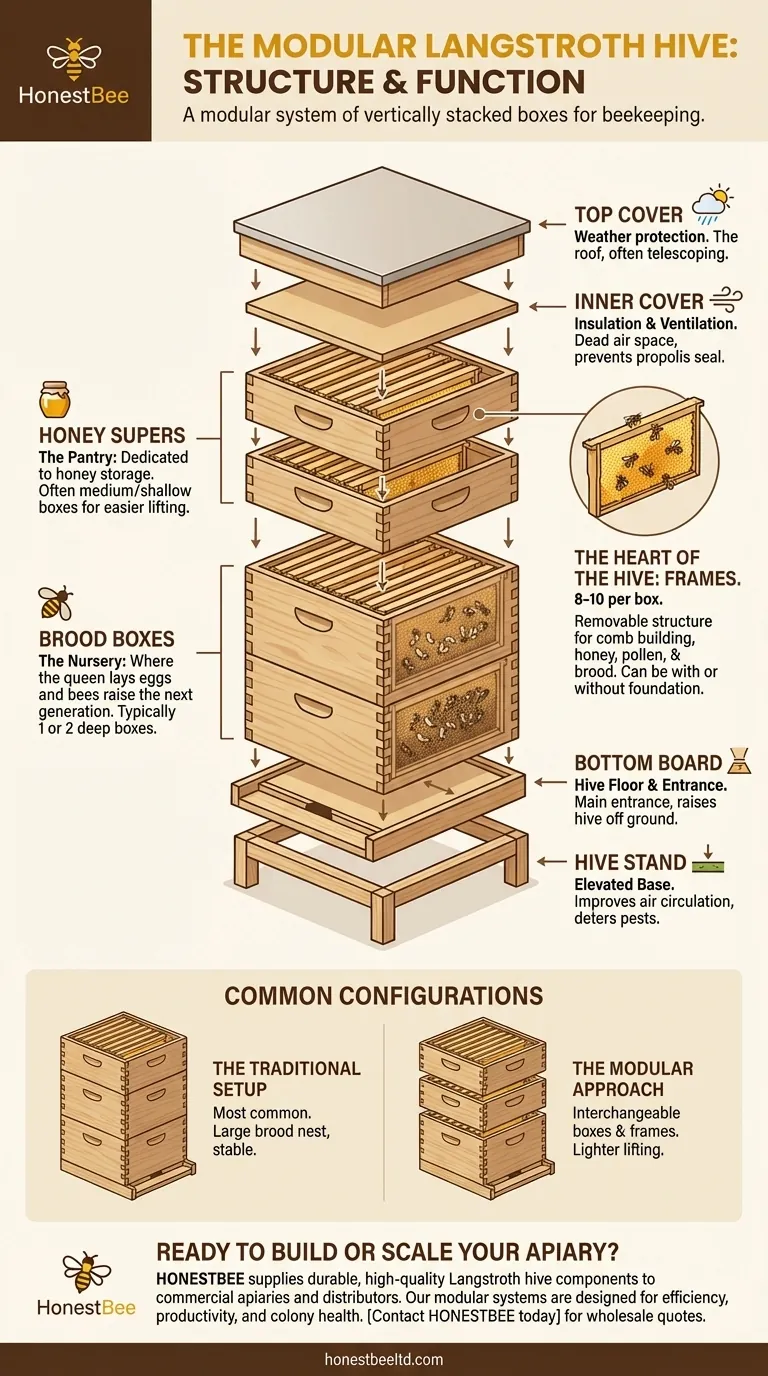At its core, a Langstroth hive is a modular system of vertically stacked boxes. Each box contains removable frames, allowing beekeepers to inspect the colony and manage honey production with minimal disturbance. The primary components are a bottom board, one or more hive boxes, an inner cover, and a protective top cover.
The genius of the Langstroth hive isn't just its parts, but its principle of modularity. This design allows the hive to expand or contract vertically, perfectly mirroring the natural growth and seasonal needs of the bee colony within it.

The Anatomy of a Langstroth Hive: A Bottom-to-Top Breakdown
A Langstroth hive is assembled in a specific order, with each component serving a distinct purpose for the health and productivity of the colony. We'll build one from the ground up.
The Foundation: Hive Stand and Bottom Board
The entire structure typically rests on a hive stand. This simply raises the hive off the damp ground, improving air circulation and deterring pests.
The first essential component is the bottom board, which serves as the floor of the hive. It creates the main entrance for the bees to come and go.
The Living Quarters: Hive Boxes
Stacked on the bottom board are the hive boxes, also known as "bodies" or "supers." These boxes are the heart of the hive, where the bees live, raise their young, and store food.
The "Ceiling": Inner and Top Covers
An inner cover sits on top of the uppermost box. It provides a dead air space for insulation, helps with ventilation to reduce condensation, and prevents the bees from gluing the main lid shut with propolis.
The final piece is the top cover (often a "telescoping" cover that overhangs the sides). This is the hive's roof, protecting the colony from rain, sun, and other weather elements.
The Heart of the Hive: Boxes and Frames
The boxes and the frames within them are where all the activity happens. They are separated by function: raising brood and storing honey.
Brood Boxes: The Nursery
The boxes at the base of the hive form the brood chamber. This is the colony's nursery, where the queen lays her eggs and the bees raise the next generation of workers.
Beekeepers typically use one or two deep boxes for this purpose, as their larger size provides ample space for the queen to lay.
Honey Supers: The Pantry
Additional boxes, called honey supers, are stacked on top of the brood chamber. These are dedicated to honey storage.
Beekeepers often use smaller medium or shallow boxes for honey supers because they are significantly lighter and easier to lift when full of honey.
Frames: The Internal Structure
Inside every box are 8 or 10 removable frames. Bees build their wax comb within these frames. This is where they store honey, pollen, and raise their brood.
These frames can come with a pre-installed foundation (a sheet of wax or plastic) to guide comb building, or they can be foundationless, allowing bees to build their comb naturally.
Understanding the Trade-offs: Common Configurations
While the components are standard, the way you combine them can be adapted to your beekeeping style, particularly regarding the boxes.
The Traditional Setup
The most common configuration for new beekeepers is using two deep boxes for the brood chamber and then adding medium supers on top for honey collection.
This method provides a large, stable area for the brood nest that typically doesn't need to be lifted during the season.
The Modular Approach
An increasingly popular method is to use all medium boxes for the entire hive, including the brood chamber. This usually requires three medium boxes to equal the space of two deeps.
The primary benefit is that every box and frame in the apiary is interchangeable. Furthermore, medium boxes are much lighter to lift than deeps, which can be a significant advantage for maneuverability and back health.
Making the Right Choice for Your Goal
Understanding these components allows you to configure a hive that matches your physical ability and management philosophy.
- If your primary focus is a traditional, industry-standard start: A setup with deep brood boxes and medium honey supers is the most common and widely understood configuration.
- If your primary focus is interchangeability and lighter lifting: Using all medium-sized boxes for both the brood nest and honey supers provides maximum flexibility and is easier to manage physically.
Ultimately, mastering the function of each component is the first step toward becoming a responsive and successful beekeeper.
Summary Table:
| Component | Function | Key Details |
|---|---|---|
| Bottom Board | Hive floor & main entrance | Raises hive off damp ground, deters pests. |
| Hive Boxes (Supers) | Living & storage space | Deep boxes for brood; medium/shallow for honey. |
| Frames | Internal comb structure | 8-10 per box; can be with or without foundation. |
| Inner Cover | Insulation & ventilation | Prevents bees from sealing the top cover. |
| Top Cover | Weather protection | The roof of the hive (often telescoping). |
Ready to build or scale your apiary with the right equipment?
HONESTBEE supplies durable, high-quality Langstroth hive components and beekeeping equipment to commercial apiaries and distributors through our wholesale-focused operations. Our modular systems are designed for efficiency, productivity, and the long-term health of your colonies.
Contact HONESTBEE today to discuss your specific needs and request a wholesale quote. Let us help you build a stronger, more productive beekeeping operation.
Visual Guide

Related Products
- Langstroth Bee Hives Bee Keeping Box for Beginners Beekeeping
- Long Langstroth Style Horizontal Top Bar Hive for Wholesale
- Solid Bottom Board Australian Pine Wood Langstroth Bottom Board for Wholesale
- Multi-Functional Sliding Hive Entrance for Beekeeping
- Ergonomic Two Person Foldable Hive Lifter
People Also Ask
- What are the key features of the Langstroth beehive? A Guide to the Standard for Modern Beekeeping
- Why might a beginner be advised to start with a Langstroth hive? Unlock a Supportive Beekeeping Ecosystem
- Why are Langstroth hives recommended for beginners? Unmatched Support & Standardization
- Should a beginner try a different type of hive? Start with a Langstroth for a solid foundation.
- How does the ease of access differ between 8-frame and 10-frame hives? Choose the Right Hive for Your Body



















